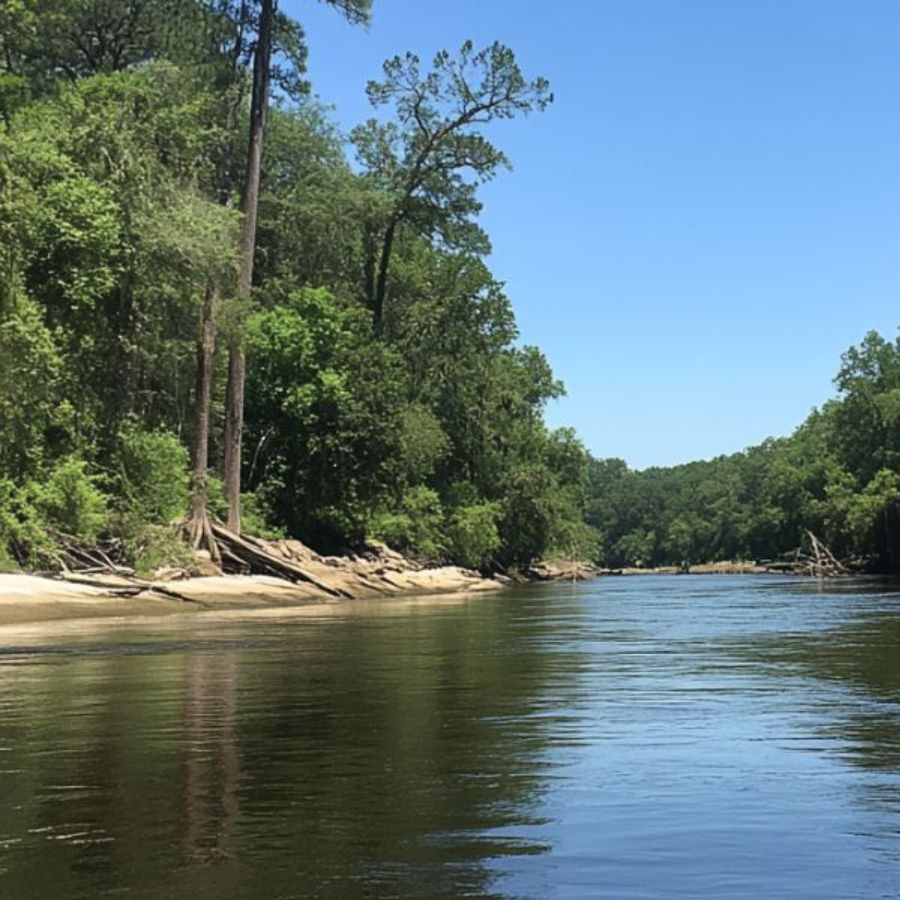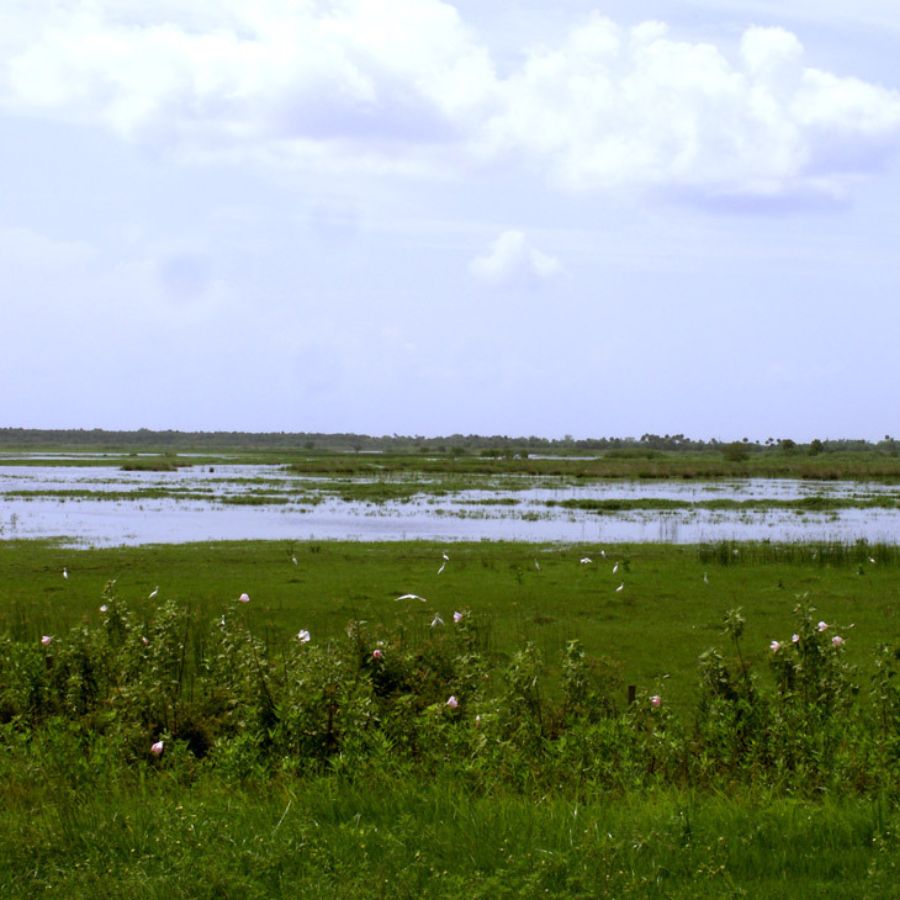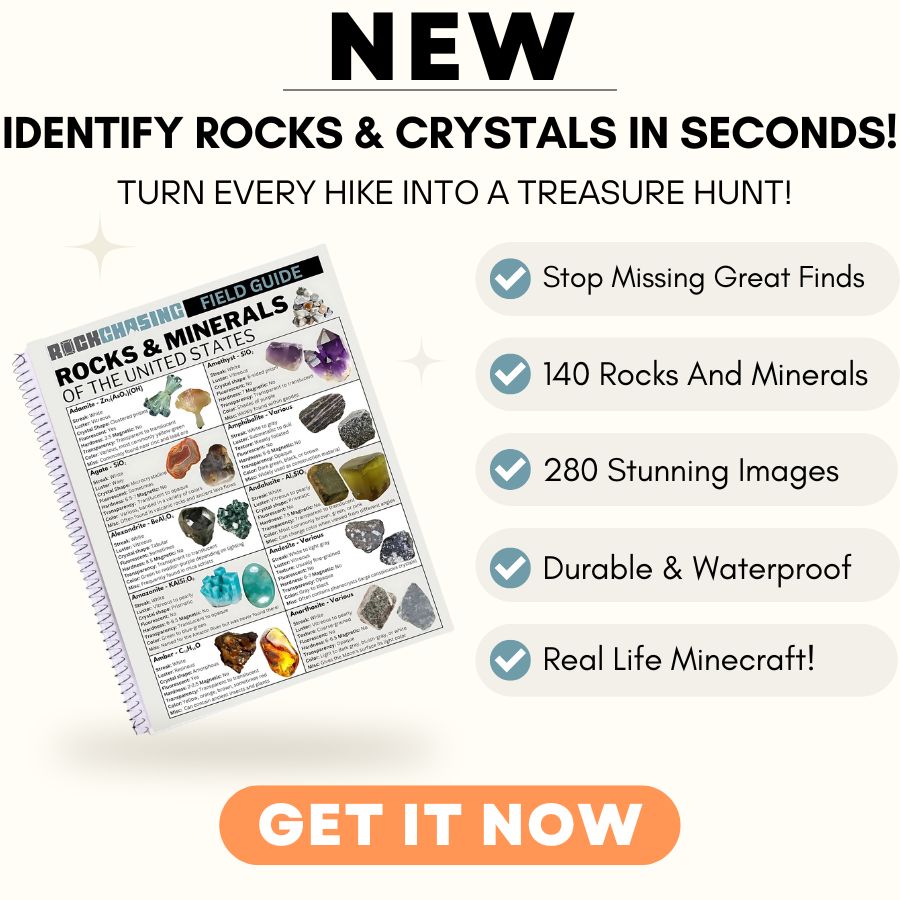Florida’s hidden copper deposits stretch from ancient Native American mines to modern-day mineral sites. Local rockhounds have discovered stunning specimens of native copper, azurite, and malachite across the state’s diverse geological formations.
Many rock collectors waste countless hours searching in common spots, missing out on the state’s richest copper locations. The frustration of coming home empty-handed after long drives and exhausting searches is all too familiar.
So, we’ve mapped out proven copper hunting grounds that most people don’t know about. Skip the trial and error – we’ll show you exactly where to look.
How Copper Forms Here

Copper forms when hot, mineral-rich fluids squeeze through cracks in rocks, they deposit copper along with other minerals. These fluids, heated by magma, can be as hot as 750°F!
The Copper usually starts out combined with sulfur, forming minerals like chalcopyrite.
Over millions of years, as these rocks get exposed to oxygen and water near the surface, the copper sulfides break down, creating different copper minerals like malachite and azurite.
Sometimes, you’ll even find pure copper in thin sheets or twisted chunks, formed when the original minerals completely broke down. This process, called supergene enrichment, creates some of the richest copper deposits we find.
Types of Copper Minerals
Copper ores come in a fascinating variety of forms, each with its own unique characteristics and composition.
Understanding these different types is crucial for both mining operations and mineral collectors, as each variety offers distinct advantages and challenges in copper extraction while presenting unique aesthetic qualities.
Chalcopyrite

Chalcopyrite catches everyone’s eye with its striking brass-yellow color and metallic shine. When exposed to air, it develops beautiful iridescent tints of blue, red, and purple.
The mineral has an interesting way of fooling people into thinking it’s gold at first glance. However, you can easily tell them apart – chalcopyrite leaves a greenish-gray streak when scratched, while gold leaves a yellow streak. It’s also more brittle than gold, which bends without breaking.
Through history, chalcopyrite has been the world’s primary source of copper. Its chemical makeup of copper, iron, and sulfur makes it perfect for copper extraction. When heated, it shows an interesting property – it becomes magnetic, which is quite unusual for a copper mineral.
Chalcocite

Chalcocite stands out with its dark, mysterious appearance, showing off deep blue-black to steel gray colors. Its surface has a metallic shine that catches light beautifully, though it often turns dull black when exposed to air for long periods.
This mineral has an amazing ability to replace other minerals while keeping their original crystal shape. It can take over minerals like bornite and pyrite, creating perfect copies of their structures. This process happens atom by atom, making chalcocite a master of mineral mimicry.
The high copper content of chalcocite makes it incredibly valuable for copper production. It contains nearly 80% copper by weight, which is one of the highest concentrations found in any copper mineral.
Covellite

Covellite dazzles with its intense indigo-blue to blackish-blue color scheme. What makes it truly special is its remarkable iridescence – it often displays brilliant flashes of blue, purple, and red when light hits its surface at different angles.
The mineral has unique physical properties that set it apart. It can be split into thin sheets along specific directions, similar to pages in a book. This perfect cleavage is rare among copper minerals and makes covellite specimens particularly interesting to study.
Covellite often contains brassy inclusions of other minerals like chalcopyrite or pyrite, creating striking contrasts against its deep blue background.
Bornite

Bornite’s fresh surfaces show a warm reddish-brown color, but when exposed to air, it develops vibrant iridescent tones of blue, purple, and gold. This stunning color transformation has earned it the nickname “peacock ore.”
The mineral’s surface changes create patterns that are never quite the same from one specimen to another. These variations in tarnishing make each piece unique, with some showing more blue tones while others might display more purple or golden hues.
Beyond its visual appeal, bornite plays a significant role in copper production due to its high copper content. The mineral’s rich composition makes it valuable beyond just its striking appearance. It often occurs alongside other copper minerals, creating interesting mineral associations.
Tetrahedrite

This metallic mineral exhibits a range of colors from steel gray to black, with hints of bronze shimmering across its surface. The crystal formations create perfect tetrahedral shapes, resembling three-sided pyramids joined together at their bases.
Tetrahedrite naturally mixes with related minerals, forming combinations with arsenic-rich tennantite and silver-rich freibergite, creating varied specimens with unique properties.
Mineral enthusiasts particularly value specimens with perfect crystal formations. These geometric shapes, combined with the metallic luster, create remarkable display pieces that demonstrate nature’s ability to form precise geometric patterns.
Dioptase

Dioptase forms brilliant green crystals that sparkle with an intense vitreous luster. These six-sided crystals showcase a color ranging from deep emerald to bright bluish-green, with remarkable transparency.
The internal architecture of dioptase reveals complex silicate rings, interconnected in a unique pattern. Water molecules trapped within these formations contribute to the crystal’s brilliant appearance while also making it more fragile than similar-looking minerals.
Scientists study dioptase’s growth patterns with great interest. The mineral forms perfect rhombohedral crystals, often growing in clusters that create stunning geometric arrangements against dark host rock.
Malachite

Fine bands of varying green shades weave through malachite, creating natural patterns resembling ripples in water. No two pieces share the same design, with each specimen displaying its own unique arrangement of light and dark green stripes.
Natural forces shape malachite into distinctive forms. The mineral develops smooth, rounded surfaces in some locations, while in others, it creates elongated formations resembling frozen green waterfalls.
Chemical stability gives malachite its enduring appeal. The vibrant green color remains unchanged even after centuries of exposure to light and air, preserving its natural beauty for generations to appreciate.
Azurite

Raw crystals of azurite radiate an intense blue color that seems to capture the essence of a deep ocean. Crystal size determines the color intensity, creating a spectrum from bright azure to midnight blue.
Growth patterns in azurite create diverse formations. Some crystals develop as elongated prisms, while others form flat plates or clusters of radiating needles, each type offering a different expression of the mineral’s beauty.
Medieval artists treasured azurite as a precious pigment source. They carefully ground the crystals to create rich blue colors for their masterpieces, a practice some traditional artists continue today.
Cuprite

The deep crimson world of cuprite reveals itself through striking crystal formations. These crystals form perfect geometric shapes – cubes, octahedrons, and twelve-sided dodecahedrons. Their color ranges from blood-red to nearly black, with surfaces that can shine like diamonds.
Inside cuprite crystals, copper and oxygen atoms arrange themselves in a precise cubic pattern. This arrangement creates fascinating penetration twins, where crystals appear to pass through each other, forming cross-shaped formations.
Over time, Cuprite can change into green malachite while keeping its original crystal shape. This process creates remarkable specimens showing both the original red cuprite and its green transformation.
The brilliant adamantine luster of cuprite makes it special among copper minerals. When light hits the crystal faces, they sparkle with an intense brightness similar to diamonds.
Chrysocolla

Chrysocolla displays swirling patterns of blue and green. These colors blend together like watercolors on canvas, creating unique designs in each specimen. Some pieces show dramatic color transitions, while others display subtle variations within a single shade.
The mineral’s structure contains copper, silica, and water molecules arranged in thin, microscopic layers. This layered structure allows chrysocolla to form interesting shapes – rounded bumps called botryoidal formations, thin crusts, and sometimes even stalactites.
When silica content increases in chrysocolla, it creates a more durable material. This variation in composition leads to different types of specimens, from soft and earthy to firm and glassy. Some pieces even contain patterns of darker minerals running through them.
What Does Native Copper Look Like?
Copper in its natural, unrefined state has distinct characteristics that make it recognizable even to amateur rock enthusiasts. Here’s how you can spot rough copper in the field or in a collection.
Check for Metallic Streaks and Malleability

Try scratching the specimen gently on unglazed porcelain or rough ceramic. Copper leaves a distinctive coppery-metallic streak, unlike other reddish minerals.
Unlike most rocks, copper is malleable – it can be dented with a nail or knife. The surface might show small indentations or hammer marks if it’s native copper.
Examine the Formation Pattern

Native copper often occurs in irregular, twisted masses or sheets. Look for dendritic (tree-like) patterns or wire-like formations – these are super distinctive to copper.
Sometimes it forms in flat sheets between rock layers or as tiny crystals in cubic or octahedral shapes. The edges are usually rounded and smooth, not sharp like quartz crystals.
Test the Conductivity and Temperature

Copper feels noticeably colder than regular rocks when you first touch it (due to its high thermal conductivity). It warms up quickly in your hand – much faster than most minerals.
If you’re really curious, touch it with a magnet; copper isn’t magnetic but will show slight resistance due to its conductivity.
A Quick Request About Collecting
Always Confirm Access and Collection Rules!
Before heading out to any of the locations on our list you need to confirm access requirements and collection rules for both public and private locations directly with the location. We haven’t personally verified every location and the access requirements and collection rules often change without notice.
Many of the locations we mention will not allow collecting but are still great places for those who love to find beautiful rocks and minerals in the wild without keeping them. We also can’t guarantee you will find anything in these locations since they are constantly changing.
Always get updated information directly from the source ahead of time to ensure responsible rockhounding. If you want even more current options it’s always a good idea to contact local rock and mineral clubs and groups
Tips on Where to Look
Copper is one of the most abundant metals you can find in nature. Here are some reliable places where you can look for copper minerals and specimens.
Abandoned Mining Areas

Old copper mines are perfect spots to hunt for copper specimens. Check out the mine dumps and tailings piles – that’s where miners tossed unwanted rocks. These areas often have chunks of copper-bearing rocks scattered around.
Look for greenish or bluish stains on rocks, as these often indicate copper minerals. The mine dumps usually have easier access and don’t require special permits, but always check local regulations first.
Stream Beds and River Banks

Water bodies near copper deposits often contain copper pieces. Search in stream gravels and sandy areas where water slows down, as heavier copper pieces tend to settle there.
During your search, pay special attention to areas where water makes sharp turns or where you spot lots of black sand, because these spots often trap heavier minerals including copper. The best time to look is after heavy rains when new material gets washed down.
Volcanic Rock Formations

Copper commonly occurs in volcanic rocks, especially basalt. Look for dark-colored volcanic rocks with small holes or bubbles in them. These vesicular basalts sometimes contain native copper in the form of small threads or chunks.
The contact zones between different rock types are particularly promising spots where you might find copper mineralization that’s been concentrated by ancient geological processes.
Sedimentary Rock Exposures

Sedimentary Rock Exposures Copper frequently shows up in sedimentary rocks, particularly sandstones and shales.
Focus on areas where you see color changes in the rock layers, especially where greens and blues meet reds. These color boundaries often indicate where copper minerals have accumulated over time.
When exploring these areas, break open rocks that show green staining on their surface as they might contain copper carbonate minerals like malachite or azurite.
Some Great Places To Start
Here are some of the better places in the state to start looking for Copper:
Always Confirm Access and Collection Rules!
Before heading out to any of the locations on our list you need to confirm access requirements and collection rules for both public and private locations directly with the location. We haven’t personally verified every location and the access requirements and collection rules often change without notice.
Many of the locations we mention will not allow collecting but are still great places for those who love to find beautiful rocks and minerals in the wild without keeping them. We also can’t guarantee you will find anything in these locations since they are constantly changing.
Always get updated information directly from the source ahead of time to ensure responsible rockhounding. If you want even more current options it’s always a good idea to contact local rock and mineral clubs and groups
Waldo

Waldo is a historic town located about 15 miles from Gainesville. The area stands out for its old mining history and rich mineral deposits.
The ground here is special because of its mix of limestone and phosphate deposits. These deposits formed millions of years ago when this area was under the sea. Scientists have found many different minerals in these layers of rock.
Copper hunters should check out the old mining spots and stream banks in the area. Look for rocks with greenish-blue stains – these often point to copper minerals. The best spots are where water has cut through the ground and exposed different rock layers.
The flat land around Waldo makes it easy to explore. Many rockhounds also find other interesting minerals while searching for copper.
Withlacoochee River

The Withlacoochee River starts in Georgia and flows down into Florida through Madison County. It meets the Suwannee River at Suwannee River State Park, near Live Oak. This river is special because it’s one of the few alluvial streams in Florida, which means it carries lots of loose soil and rock materials.
Natural springs, like Madison Blue Spring, feed into the river and change how the water flows and what minerals it contains. The river’s constant movement and flooding help bring minerals to the surface, including copper deposits.
Good spots include the riverbed and banks, especially after floods when new materials get exposed. The river’s changing paths have created many spots where minerals collect over time.
Spring-fed areas are particularly good for finding copper because the springs bring up minerals from deep underground.
South Jacksonville

South Jacksonville sits in the northeastern part of the state, right along the Atlantic coast. The St. Johns River flows through this urban area, creating unique mineral deposits along its banks.
Copper finds in this area are often connected to old mining spots, especially near the Jacksonville Placer deposits. The area’s sandy coastal grounds make it easier to spot minerals. Most copper pieces show up in places where other heavy minerals are present.
The mix of sandy beaches and coastal deposits creates perfect conditions for mineral formation.
Visitors should check around the unnamed titanium deposits, as these locations have produced copper findings in the past.
Lakeland

Lakeland is a city known for its numerous lakes and its central location within the state. This area’s history with phosphate mining makes it special for finding copper and other minerals.
The Clear Springs Mine and Saddle Creek-Ebersbach Mine are great spots to look for copper. These old mines have layers of rock that formed millions of years ago when the area was under the sea. Over time, minerals got trapped in these layers, creating perfect spots for copper to form.
The copper here often appears as small green or blue-tinted minerals mixed with other rocks. Local geology clubs sometimes organize trips to these sites, helping new collectors learn where to look.
Ballast Point

Ballast Point sits along Hillsborough Bay in Tampa. This neighborhood has a rich history of mineral discoveries, making it popular among rock collectors.
The best spots to look for copper are around Ballast Point Park’s shoreline, especially after storms when waves wash up new rocks. The park’s beach areas have produced good finds.
Local collectors say early morning searches, when the tide is low, give the best results. The rocks near the fishing pier also hold promise for copper hunting.
This spot is special because it combines easy access with regular mineral deposits from the bay’s natural processes.
Places Copper has been found by County
After discussing our top picks, we wanted to discuss the other places on our list. Below is a list of the additional locations along with a breakdown of each place by county.
| County | Location |
| Bradford | Lawtey |
| Okeechobee | Ruck’s Pit |
| DeSoto | Peace River |
| Sarasota | Venice Beach |
| Suwannee | Suwannee River |
| Hernando | Brooksville |
| Charlotte | Englewood Beach |
| Pinellas | Dunedin Causeway |
| Jackson | Cottondale |
| Washington | Chipley |
| Jackson | Marianna |


